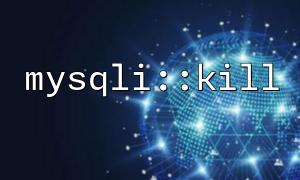In PHP, the mysqli::kill function is used to terminate an active MySQL connection. When working with MySQL databases, especially in high-concurrency environments, there may be situations where you need to kill a specific connection. The primary purpose of this function is to close a particular MySQL connection by its connection ID, helping to prevent performance issues caused by long-running queries or other problems. However, although mysqli::kill is very useful in some cases, it also poses certain security risks, particularly when used improperly.
The basic syntax of the mysqli::kill function is as follows:
<span><span><span class="hljs-keyword">bool</span></span><span> mysqli::</span><span><span class="hljs-variable constant_">kill</span></span><span> ( </span><span><span class="hljs-keyword">int</span></span><span> </span><span><span class="hljs-variable">$process_id</span></span><span> )
</span></span>$process_id: The connection ID to terminate, usually the thread ID in the MySQL database.
If the function executes successfully, it returns true; otherwise, it returns false. In PHP, developers typically obtain a valid MySQL connection first, then query to get the process_id of the connection that needs to be terminated, and finally use mysqli::kill to kill the connection.
While the mysqli::kill function is effective when used correctly, it also carries some potential security risks. The following are common security issues:
The execution of the mysqli::kill function is typically restricted by the MySQL user's privilege level. By default, only MySQL users with the SUPER privilege can perform the KILL operation. Therefore, if a malicious user somehow gains SUPER privileges on the database, they could abuse the mysqli::kill function to interrupt other legitimate users' connections, causing instability in the database service.
The mysqli::kill function requires a valid connection ID (usually a MySQL thread ID). If an incorrect connection ID is passed, it might terminate a connection involved in critical operations, leading to business interruptions or data inconsistencies. For example, if a long-running query is mistakenly killed during execution, the query may fail to complete, potentially affecting transactional data.
Although mysqli::kill is primarily used to manage MySQL connections, if it is used insecurely in combination with user inputs, it could open the door to SQL injection attacks. If developers do not properly validate and sanitize input parameters, malicious users might craft harmful inputs that interfere with database connection management or even execute unauthorized operations.
To prevent the above security problems, developers can take the following protective measures:
In production environments, ensure that database users have only the necessary permissions. Especially for regular users, avoid granting SUPER or other risky privileges. If the KILL operation is needed, use a dedicated admin account with restricted scope.
When using the mysqli::kill function, ensure the connection ID passed is legitimate and validated. To prevent SQL injection, developers should always filter and sanitize user inputs carefully. For example, use the intval() function to ensure the input is a valid integer, avoiding malicious SQL code input.
<span><span><span class="hljs-variable">$process_id</span></span><span> = </span><span><span class="hljs-title function_ invoke__">intval</span></span><span>(</span><span><span class="hljs-variable">$_GET</span></span><span>[</span><span><span class="hljs-string">'process_id'</span></span><span>]); </span><span><span class="hljs-comment">// Ensure the input is an integer</span></span><span>
</span><span><span class="hljs-keyword">if</span></span><span> (</span><span><span class="hljs-variable">$process_id</span></span><span> > </span><span><span class="hljs-number">0</span></span><span>) {
</span><span><span class="hljs-variable">$mysqli</span></span><span>-></span><span><span class="hljs-title function_ invoke__">kill</span></span><span>(</span><span><span class="hljs-variable">$process_id</span></span><span>);
}
</span></span>When executing mysqli::kill, error handling should be in place to receive timely feedback if killing the connection fails. For instance, use try-catch blocks to catch possible exceptions and log detailed error messages for further investigation.
<span><span><span class="hljs-keyword">try</span></span><span> {
</span><span><span class="hljs-keyword">if</span></span><span> (!</span><span><span class="hljs-variable">$mysqli</span></span><span>-></span><span><span class="hljs-title function_ invoke__">kill</span></span><span>(</span><span><span class="hljs-variable">$process_id</span></span><span>)) {
</span><span><span class="hljs-keyword">throw</span></span><span> </span><span><span class="hljs-keyword">new</span></span><span> </span><span><span class="hljs-built_in">Exception</span></span><span>(</span><span><span class="hljs-string">"Failed to kill process with ID: <span class="hljs-subst">$process_id</span></span></span><span>");
}
} </span><span><span class="hljs-keyword">catch</span></span><span> (</span><span><span class="hljs-built_in">Exception</span></span><span> </span><span><span class="hljs-variable">$e</span></span><span>) {
</span><span><span class="hljs-comment">// Log the error</span></span><span>
</span><span><span class="hljs-title function_ invoke__">error_log</span></span><span>(</span><span><span class="hljs-variable">$e</span></span><span>-></span><span><span class="hljs-title function_ invoke__">getMessage</span></span><span>());
}
</span></span>Avoid exposing the mysqli::kill function in public user interfaces or shared environments. Only authenticated and authorized users in specific admin panels should be allowed to perform this operation to reduce the risk of abuse. Ensure proper access control is in place for administrative actions within web applications.
mysqli::kill is a powerful tool that helps developers terminate unnecessary or problematic MySQL connections when needed. However, improper use can lead to security risks such as privilege abuse, accidental termination of connections, and SQL injection vulnerabilities. Therefore, developers should implement appropriate security measures, including minimizing privileges, validating inputs strictly, setting up robust error handling, and restricting the function’s usage scope. These practices can effectively ensure the security and stability of the database.
Related Tags:
mysqli

